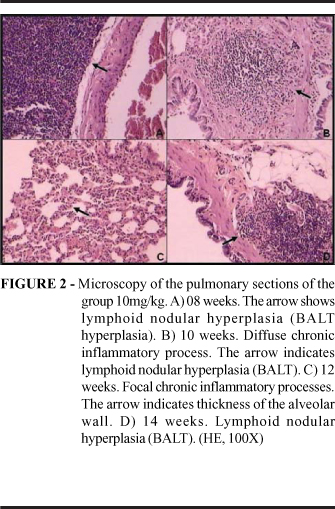PURPOSE: To elaborate an experimental model of pulmonary carcinogenesis in Wistar rats. METHODS: Male Rattus norvegicus albinus, Wistar lineage was carried through an intra-pulmonary instillation of the Benzo[a]pyrene (B[a]P) dilution in alcohol 70%, a polycyclic aromatic hydrocarbon widely known by its power of tumoral induction. Three experimental groups had been formed with 08 animals each: Control Group (Alcohol 70%); B[a]P Group 10 mg/kg; e B[a]P Group 20mg/kg, submitted to euthanasia 08, 10, 12 and 14 weeks after the experimental procedure. The pulmonary sections had been colored by hematoxilin-eosin (HE) and submitted to the morphometrical analysis to describe the tissue alterations. RESULTS: The presence of diffuse inflammatory alterations was observed in all groups, however, at the analysis of the pulmonary tissue of the experimental groups, it had been observed hyperplasic alterations (BALT hyperplasia), and in one of the animals of the experimental group 20mg/kg (12 weeks), it was noticed the presence of cellular epithelial tracheal pleomorphism, suggesting the adenocarcinoma formation in situ. CONCLUSION: The main secondary alterations to the intra-pulmonary instillation of B[a]P in Wistar rats were: cellular proliferation, inflammatory alterations of several degrees and nodular lymphoid hyperplasias. The association of an activator agent of the pulmonary metabolic reply is necessary to establish the ideal reply-dose to the development of the lung cancer.
Carcinogenesis; Lung Cancer; Benzo[a]pyrene; Neoplasms; Experimental model




